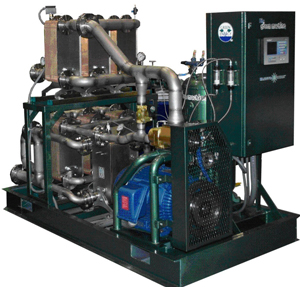December 12, 2011
Waste Heat To Power From A Stationary Internal Combustion Engine
In the 4th Quarter addition of the Gas Machinery Journal Gulf Coast Green Energy’s white paper on small scale waste heat to power generation highlights the efficiency of capturing waste heat for on-sight power generation. Converting waste heat to power as a form of distributed generation is becoming a serious part of many company’s fiscal and environmental plan. The benefits to the company installing Gulf Coast Green Energy waste heat to power equipment include lower cost of power, fixed cost of power, internal rates of return from 12-22%, and significantly reduced emissions into the atmosphere.
An excerpt from the Gas Machinery Journal:
“Internal combustion engines (ICE) create a great deal of waste heat which goes out of the exhaust stack and into the atmosphere. A recent demonstration project at an oil and gas well-head in Texas has shown that a new combined heat and power technology is cost effective at producing fuel-free/emission-free renewable electric power and helps to resolve overheating issues that are so common with ICE engines, especially in warmer months. The operational benefits of the new combined heat and power generation technology include:
- On-site power generation
- Reduction of internal heat thereby reducing downtime due to overheating and often eliminating overheating entirely
- Greatly reduces the heat going into the atmosphere
Converting waste heat to power provides many advantages for companies including off-setting operational cost, on-sight generation of fuel-free, emission free electric power and the other public relations advantages for using green energy.
This new concept is being demonstrated by Gulf Coast Green Energy (GCGE) on a natural gas compressor engine located at a natural gas well field in Jackson County, Texas. GCGE assists companies in generating fuel-free, emission-free green energy by capturing waste heat and turning it into electric power. GCGE estimates that in the U.S. and Canada, over 600 MW could be generated from capturing waste heat from ICE gas compressor engines alone and does not include gas turbine compressors. That is equivalent to powering over 500,000 homes per year.
GCGE is using the engine cooling jacket water waste heat from a Caterpillar 399 compressor owned by Houston’s Valerus Compression to generate 18-24 kWh of electricity. This project marks the first commercial ICE application of the Green Machine and is the first commercially viable installation of a small-scale waste heat power generator producing less than 65 kWh. In addition to capturing surplus waste heat for generating emission-free electricity suitable for distributed generation on-site power needs or resale to the local power company. The waste heat removed by the Green Machine also solves a big problem for many ICE’s by reducing the engine temperature by as much as 20F degrees.
Internal combustion engines (ICE’s) are used to drive huge compressors, because natural gas must be compressed at regular intervals to keep it flowing through pipelines. Heat is created by the ICE’s which must be cooled and which goes out the exhaust stack. This is waste heat if it’s not used to generate profits.
Here is where the Green Machine comes in, and the way it works. The 185F jacket water is redirected from the box cooler (radiator) to the Green Machine. The heat is then reduced and used to pressurize and vaporize the Honeywell R-245 refrigerant which then drives the patented twin screw expander. The expander is belted to an induction generator and the power is delivered to Jackson Electric Co-op. The water is then returned to the engine without the need for additional cooling in the box cooler. This is a major benefit in warmer months because costly additional cooling is not needed, and downtime is reduced by eliminating overheating of the ICE. The Green Machine has logged more than 4600 hours of operation to date at this site which sees temperatures over 100F degrees in the summer.
Read More….”

